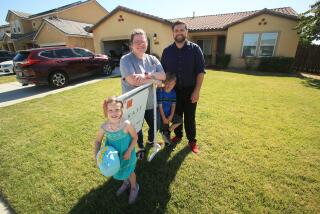Many Americans are still struggling financially
- Share via
Reporting from washington — Four in 10 U.S. households are straining financially five years after the Great Recession — many struggling with tight credit, soaring education debt and profound issues related to savings and retirement, according to a new Federal Reserve survey.
The wide-ranging Fed study assessing the economic well-being of Americans shows that the economy has made progress to the point where most households said they were “living comfortably” or doing OK financially.
But almost 40% reported last fall that their families were “just getting by” or struggling to do so, and more people said their financial situation was worse rather than better off compared with five years earlier.
The survey, conducted in September and reported Thursday, found that the recession had forced substantial shares of the population to put off big purchases or delay major decisions such as moving to a new city or getting married. And many people leaned on others to get through the hard times.
“The survey indicates that many households have been providing assistance to one another during periods of financial distress,” the 100-page Fed report said, noting that 34% helped friends or family with money.
Overall, the Fed’s findings are consistent with many other studies and data depicting the deep and lingering effects of the 2007-09 recession. They provide fresh evidence that the recovery has been slow and uneven, generally skewed to the wealthy, and flesh out with numbers some commonly held assumptions.
The survey found, for example, that 15% of those who had retired since 2008 had done so earlier than planned because of the downturn. Only 4% said they had retired later than expected. Based on demographics, that translates into roughly 2 million more people retiring since 2008 than if the recession had not occurred.
“This suggests that some of the folks who dropped out of the labor force during the recession will not be returning,” said Scott Hoyt, an economist at Moody’s Analytics.
That could factor in to the current debate inside the Fed and among academics about the extent of labor market slack, that is, the number of people who are not in the workforce but willing and capable of filling a job.
Fed Chairwoman Janet L. Yellen has argued in favor of easy-money policies largely on the basis of her belief that there is significant slack in the economy, but others have maintained that there are far fewer such workers who are waiting in the wings.
The Fed’s report, however, captured a snapshot of households last fall, so there is no comparable data from prior years to assess changes over time. Since then, the recovery stalled in the winter, bounced back in the spring and produced six straight months of job growth surpassing 200,000 each.
The central bank conducts a far more extensive survey of consumer finances every three years, but the results of the most recent one, for 2013, won’t be released until early next year.
Even so, this latest snapshot, which the Fed said was aimed at monitoring the recovery and risks to financial stability, adds to the understanding of the severity of the Great Recession’s effect on households and individuals. The report suggested that Americans had a fairly positive outlook about their finances. More than 60% said they expected their income to stay the same in the next 12 months, with 21% looking for it to increase. Only 16% expected it to decline.
Similarly, a plurality of homeowners — 60% of respondents said they own homes — said they expected their houses to rise in value over the next year.
The recession has turned more Americans into renters, yet the survey suggests that’s not because they aren’t interested in being homeowners. The most common reasons people gave for renting were because they couldn’t afford a down payment or couldn’t qualify for a mortgage.
On loans in general, about one-third of consumers were turned down or given less credit than they had sought. An additional 19% reported putting off applying because they figured they would be rejected.
More recently, however, there are indications that lenders are loosening up. Separately, the Fed reported Thursday that consumer borrowing rose in June at a solid 6.5% annual pace, mostly the result of gains in auto and student loans.
About one-fourth of households have education debt of some kind, according to the survey. The average amount was $27,840 — a hefty sum that left nearly one-fifth of the borrowers behind in payments or facing collections.
Financial strains also were evident in health spending: About one-third of respondents said they had put off medical care in the prior 12 months because they could not afford it.
Also, fewer than 40% of households had a rainy-day fund to cover expenses for three months.
More to Read
Inside the business of entertainment
The Wide Shot brings you news, analysis and insights on everything from streaming wars to production — and what it all means for the future.
You may occasionally receive promotional content from the Los Angeles Times.











